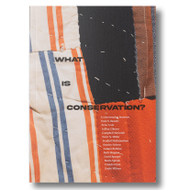Conserving Active Matter
Peter N. Miller and Soon Kai Poh, editors
Conserving Active Matter draws together the main lines and interim conclusions of a five-year research project embedded in a ten-year effort to reimagine the relationship between conservation knowledge and the humanistic study of the material world—Cultures of Conservation. The effort to conserve things is part of the human struggle with the pervasive activity of matter. For as long as people have made things and kept things, they have cared for them and repaired them. The field of conservation developed in Europe and the United States and then spread around the world. Today’s conservator uses a variety of tools and categories developed over the last 150 years to do this work. But in the next decades, new kinds of materials and a new scale of change will pose unprecedented challenges. Thinking through the lens of “active matter,” as understood by philosophers, historians, materials scientists, conservators, and those who work on Indigenous artifacts, this project raises questions and establishes new lines of inquiry for the future rethinking of conservation and the human sciences of the object.
The exhibition Conserving Active Matter is on view at Bard Graduate Center Gallery from February 25 through July 10, 2022.
Peter N. Miller is dean and professor at Bard Graduate Center.
Soon Kai Poh is a conservator and Andrew W. Mellon Foundation Postgraduate Fellow at Bard Graduate Center.
Table of Contents
Preface: Report on a Research Project
Acknowledgments
Introduction: Conserving Active Matter and the Conservator
Soon Kai Poh
Introduction: Conserving Active Matter and the Historian
Peter N. Miller
I. Philosophy
1. Introduction: Active Matter—Some Initial Philosophical Considerations
Ivan Gaskell and A. W. Eaton
2. The Expressive Import of Degradation and Decay in Contemporary Art
Sherri Irvin
3. The Look of Age: Appearance and Reality
Carolyn Korsmeyer
4. The Aesthetics of Repair
Yuriko Saito
5. Death and Entanglement: Some Thoughts about Life, Love, and the Aims of Art Conservation
Alva Noë
II. History
6. Introduction: Conserving Active Matter and the Art Historian’s Craft
Ittai Weinryb
7. Active Matter in Presocratic Thought?
André Laks
8. Active Matter: A Philosophical Aberration or a Very Old Belief?
Guido Giglioni
9. Oak and Oil, Chalk and Flint—Rood Screens and Churches
Spike Bucklows
10. Bread and Wine, Body and Blood
Lee Palmer Wandel
III. Indigenous Ontologies
11. Introduction: For the Lives of Things—Indigenous Ontologies of Active Matter
Aaron Glass
12. Living Knowledge in Cultural Collections
Sven Haakanson
13. The Orator’s Dilemma: Wampum as Material, Media, Medicine, and Memory
Jamie Jacobs
14. Always Becoming Better Stewards: Caring for Collections at the National Museum of the American Indian
Kelly McHugh
15. Hoki Mauri: Bring Back the Life Essence
Rose Evans
IV. Materials
16. Introduction: Developing Informed and Sustainable Responses to the Alteration of Cultural Artifacts; Materials Engineering Meets Material Culture
Jennifer L. Mass
17. Contextualizing the Installation of Tania Bruguera’s Untitled (Havana 2000)
Chris McGlinchey
18. Moving beyond the Binaries: Exploring the Active Matter of Metal Soaps in Paint
Francesca Casadio
19. Characterizing the Immaterial: Noninvasive Imaging and Analysis of Stephen Benton’s Engine no. 9
Marc Walton, Pengxiao Hao, Marc Vermeulen, Florian Willomitzer, and Oliver Cossairt
20. Making Meiji Red: Semiotic Activity in the Colors of Japanese Woodblock Prints, 1864–1900
Marco Leona and Henry D. Smith II
Appendix: Events of the Research Project Conserving Active Matter
Index
Contributors
Sample Chapter
Preface: Report on a Research Project
Peter N. Miller
Other Details
ISBN
9781941792322
Page count
402 pages
Publication date
2022
Binding
Hardcover



